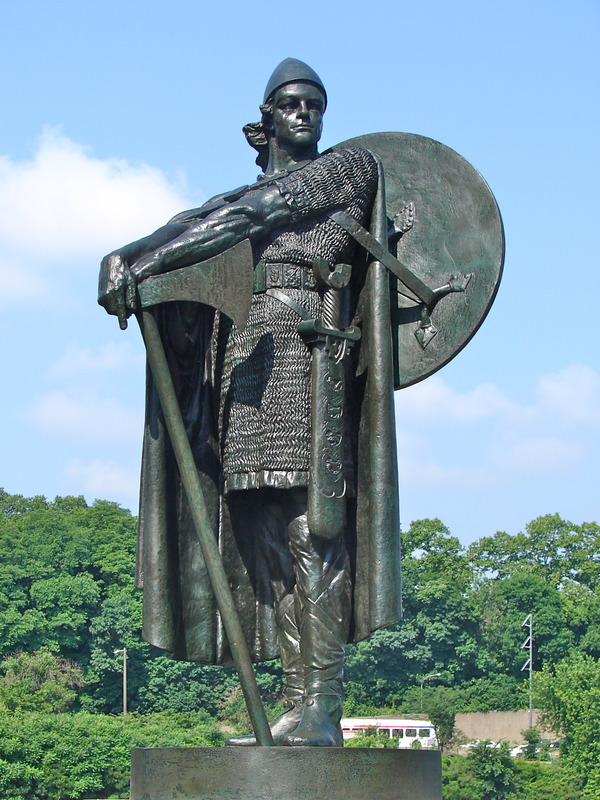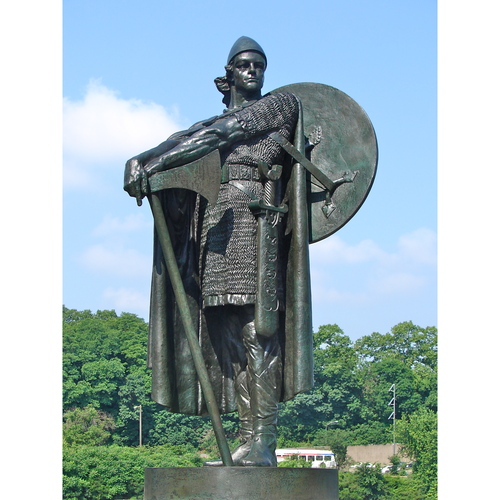
Source: Courtesy of Wikimedia Commons
THORFINNR karlsefni THORDARSON, first European to attempt to found a settlement on the American mainland; fl. 1000–20.
Thorfinnr was a wealthy Icelandic merchant who had made many merchant voyages before going to Greenland shortly after the year 1000 a.d. There he married Gudridr, the widow of Thorsteinn, the son of Eirikr Thorvaldsson (Eric the Red). Some time between the years 1003 and 1015 Thorfinnr led an expedition to colonize Vinland. The course he followed and the location of his settlement have elicited much speculation, as is the case with the voyage of Leifr heppni Eiriksson. The most detailed account of Thorfinnr’s venture is found in the Saga of Eric the Red, but it is vague enough to have given rise to widely divergent views. There is no agreement among scholars, but a tentative and not unconvincing case may be made for the following itinerary.
Thorfinnr and about 160 men and women left the Eastern Settlement of Greenland and sailed first to the Western Settlement. Then with a north wind at their back they reached Helluland (Baffin Island) in two days. Again a north wind carried them in two days to Markland (northern Labrador). The expedition coasted southward for a long time until they came to a ness (headland), to which they gave the name Kjalarnes (Keelness, possibly Cape Whittle) because they found the keel of a vessel there. The land lay upon the starboard and they sailed along its long strands and sandy banks, which they named Furdustrandir (Wonder Strands, possibly the south coast of Labrador).
The land then became indented with bays. They sailed into one where the current was very strong; to it they gave the name Straumfjord (Bay of Strong Currents, possibly Baie des Sept-Îles) and to an island at its mouth, literally covered with birds and their nests, the name Straumey. Here they wintered and were hard pressed, for the weather proved severe and they had taken no steps to lay in provisions.
Part of the expedition now left to return to Greenland, while Thorfinnr and the rest proceeded southward to find Vinland. They came to a landlocked bay, which they called Hop. Here, according to different versions of the saga, they spent either about two months or (more likely) a year. They found self-sown wheat growing on low-lying ground and vines or grapes on higher ground. There was an abundance of fish and many animals of all kinds in the woods. The winter was mild with no snow and plenty of forage for the cattle. Hop is difficult to identify because of the discrepant accounts in the saga, but the description would fit Cape Cod.
At Hop the expedition first met the indigenous people of the country whom they called Skrælingjar (possibly meaning “small,” “withered”). According to the Icelanders’ description, they were “swarthy” and “ill-countenanced,” with “large eyes” and “broad cheeks.” At first, relations with them were friendly and the Icelanders bartered gaudy cloth for skins to their great profit, but a bull frightened the Skrælings and they fled. However, they returned in three weeks and battled with the Icelanders, who were saved by Freydis, the daughter of Eirikr Thorvaldsson (Eric the Red). It is impossible, though many attempts have been made, to determine with certainty whether the Skrælings were First Nations or (more likely) Inuit.
Discouraged, it seems, by the hostility of the indigenous people, Thorfinnr returned to Straumfjord. He then sailed northward along Furdustrandir, rounded Keelness and continued westward with very heavily wooded land on the larboard, until he reached a river flowing from east to west. Here Thorvaldr, the brother of Leifr Eiriksson, had been killed by a one-legged man (einfatingr; some regard this word as a scribal error for innfadingr, or “native”) on his expedition (c. 1003–4). Having explored the country to some extent and finding it unattractive and the inhabitants unfriendly, Thorfinnr returned to Straumfjord and wintered there. In the spring the whole expedition, including the three-year-old son of Thorfinnr, Snorri, who was born at Straumfjord, returned to Greenland, ending the first – and what proved to be the only – attempt of the Icelanders in Greenland to settle on the North American continent. Thorfinnr, with his wife and son, soon returned to Iceland and resumed residence there.
The Saga of the Greenlanders includes a very brief account of Thorfinnr’s expedition. It gives no names to localities, but describes the region where Thorfinnr settled in the same terms as the Saga of Eric uses of Hop. It also describes rather differently some details of the encounters with the Skrælings. In the 1960s a team of archeologists excavated the remains of a Norse settlement at L’Anse aux Meadows (Newfoundland), dating it to the 11th century.
See the works cited under Bjarni Herjólfsson and Leifr heppni Eiriksson [Appendix]. Also Oleson, Early Voyages, 24–25, 33.
Revisions based on:
Parks Canada, “L’Anse aux Meadows national historic site”: www.pc.gc.ca/en/lhn-nhs/nl/meadows (consulted 14 May 2020).
Cite This Article
T. J. Oleson, “THORFINNR karlsefni THORDARSON,” in Dictionary of Canadian Biography, vol. 1, University of Toronto/Université Laval, 2003–, accessed April 26, 2025, https://www.biographi.ca/en/bio/thorfinnr_thordarson_1E.html.
The citation above shows the format for footnotes and endnotes according to the Chicago manual of style (16th edition). Information to be used in other citation formats:
| Permalink: | https://www.biographi.ca/en/bio/thorfinnr_thordarson_1E.html |
| Author of Article: | T. J. Oleson |
| Title of Article: | THORFINNR karlsefni THORDARSON |
| Publication Name: | Dictionary of Canadian Biography, vol. 1 |
| Publisher: | University of Toronto/Université Laval |
| Year of publication: | 1966 |
| Year of revision: | 2021 |
| Access Date: | April 26, 2025 |



